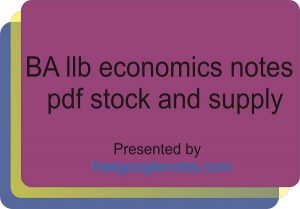Table of Contents
BA LLB economics notes pdf stock and supply
In the below post you will read BA LLB economics notes pdf stock and supply
for more please follow @blogger_priya
Q. 2. What is the supply? Discuss the factors on which the supply of a commodity depends.
Ans. Stock and Supply
The supply of a commodity is often confused with the stock of that commodity available with the producers. The stock of a commodity, more or less, will equal the total quantity produced during a period less the quantity already sold out. But we know: that the producers do not offer the whole of their stock for sale in the market.
We also know that the producers very often resort to such practices as hoarding and speculation with the object of earning more profits. A large part of the agricultural produce is kept back in the cold storage at the time. of harvest and is taken out of these storages during the off-season, because at that time it could fetch better prices.
Similarly, a part of industrial production is kept back in the godowns and is offered for sale in the market when it can fetch better prices. In other words, the amount for sale may be less (or at the most in the rare circumstances equal to) than the stocks of the commodity. The term ‘supply’ shows a relationship between quantity and
price.
By supply, we mean various quantities of a commodity that a producer will offer for sale at a particular time at various corresponding prices.

Factors on which Supply of a Commodity depends or Determinants of Supply
The supply of a commodity depends upon a number of factors. The important determinants of, supply can be grouped together in a supply function as follows:
SN=f(Pn, PrF’, T, G)
The supply function describes the functional relationship between the supply of a commodity (say N) and other determinants of supply i.e, price of the commodity (Pa). price of a related commodity (Pr), prices of the factors of production (), technical know-how (T), and goals or general objectives of the producer, each of these factors influence supply in a different way. To isolate the effect of other factors, we take other factors as constant, while considering the relationship between supply and one of the above variables.
For example, if we want to study the relationship between price and supply of commodity N. we shall assume other factors like PR F, T, and G to remain constant or unchanged. We study below these relationships :
(i) Price of the commodity. The most important determinant of the supply of a commodity is its price. The higher the price of a commodity, the producers will produce more quantities for sale in the market. This type of relationship between price and quantity supplied is įllustrated by the law of supply. We will study this law in detail in the following section.
(ii) Price of the related goods. The supply of a commodity also depends upon the prices of the related goods, especially substitute goods. If the price of substitute goods goes up, producers will be tempted to produce substitute goods. For example, if the price of wheat goes up the land will be put under cultivation of wheat, instead, say that of pulses. Supply of wheat will increase, whereas that of pulses will fall.
(iii) Price of the factors of production. Prices of the factors of production used in the production of a commodity constitute the cost of production of this commodity. If the prices of these actors go up its total cost of production may rise. In such a situation, the producers may divert their resources to the production of some other commodity, which Can be produced at a lower cost. As a result, the supply of this commodity will decrease.
(iv) Goals of producers. Ordinarily, every firm tries to attain maximum profits. But at times, individual producers may be induced to TCase the supply of a commodity not because it brings in more prons 0rthem, but because its supply in the market is a source of status and prestige in the market.
(v) State of technology. Over time, technical knowledge changes. discoveries and innovations help raise the productivity of the factors and thus contribute to the raising of the supply upwards.
(vi) Natural factors. The supply of agricultural goods to a great extent depends upon the natural conditions. Adequate rain, the fertility of the land, irrigation facilities. favorable climatic conditions, etc., help in raising the supply of agricultural produce. Contrary to that, heavy rains, floods, drought conditions,, etc., adversely affect agricultural production.
(vii) Means of transportation and communication. Proper development of means of transportation and communication helps in maintaining an adequate supply of commodities. In the case of short supply, goods can be rushed from the surplus areas to the deficient areas. But, if the developed means or transportation are used to export goods, it will create a scarcity of goods in the domestic market.
(viii) Taxation policy. The imposition of heavy taxes on a commodity discourages its production, and as a result, its supply diminishes. On the other hand, tax confession of various kinds of induces producers to raise the supply.
(ix) Further expectations of rising in price. If the producers expect an increase in the price in the near future, then they will curtail the current supply, so as to offer more goods in the future, at higher prices.
(x) Agreement among the producers. Sometimes the producers of a commodity form their association or enter into an agreement so as to earn large profits. It motivates them to create an artificial scarcity of the commodity.


